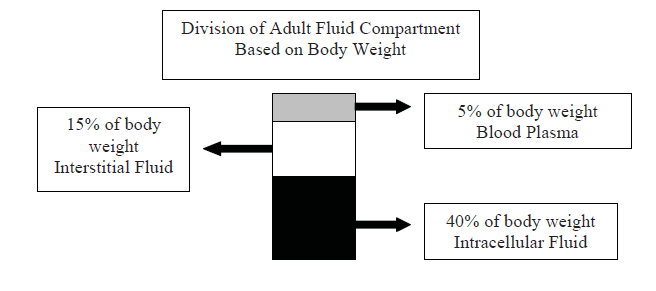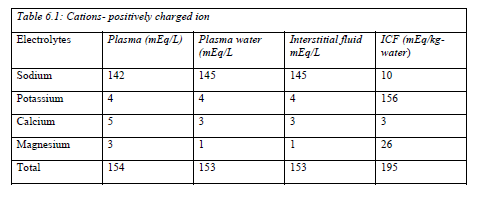Overview of Fluid and Electrolytes
Overview of Fluid and Electrolytes
Water is the major component of all fluid compartments within the body. Total body water represents approximately 60% of body weight in an average adult. The compartments are separated by water permeable cell membranes. In the adult, the intracellular fluid volume represents two thirds of total body water, and extracellular fluid volume represents one third. The major components of the extracellular compartment are the blood volume (60 to 65 mL/kg) and the interstitial fluid volume (120 to 165 mL/kg). The plasma volume, representing the non- cellular component of blood, is a fraction of the blood volume based on the hematocrit. Typical plasma volume in the adult is 30 to 35 mL/kg. The blood volume is distributed as 15% in the arterial system and 85% in the venous system. Plasma is continuously seeking equilibrium with the interstitial fluid (Figure 6.1).

The relative percentage of water varies significantly with age, gender, and adiposity or weight. Total body water can be divided into two basic components, intracellular and extracellular.
A major difference between plasma and interstitial fluid is the much higher concentration of proteins in plasma, resulting in a plasma oncotic pressure 20 mm Hg greater than the interstitial oncotic pressure. This gradient helps maintain the intravascular volume. Electrolyte balance is influenced by parenteral fluid administration.
Some patients present for surgery with electrolyte abnormalities related to loss of specific gastrointestinal fluids. Maintenance requirements for the adult include daily intake of 1.5to2.5L of water, 50 to 100 mEq sodium and 40 to80 mEq potassium via enteral or parenteral routes.
Electrolyte
Electrolyte is a chemical compound that separates into ions in a solution or when molten, and is able to conduct electricity. The electrolytes are suspended in the body's water compartments, and thus a loss of water will cause a loss of electrolytes. The body fluid compartments differ in concentration of electrolyte. The following tables (Table 6.1 and 6.2) show the distribution, composition and concentration of electrolytes in different body fluid compartments.

